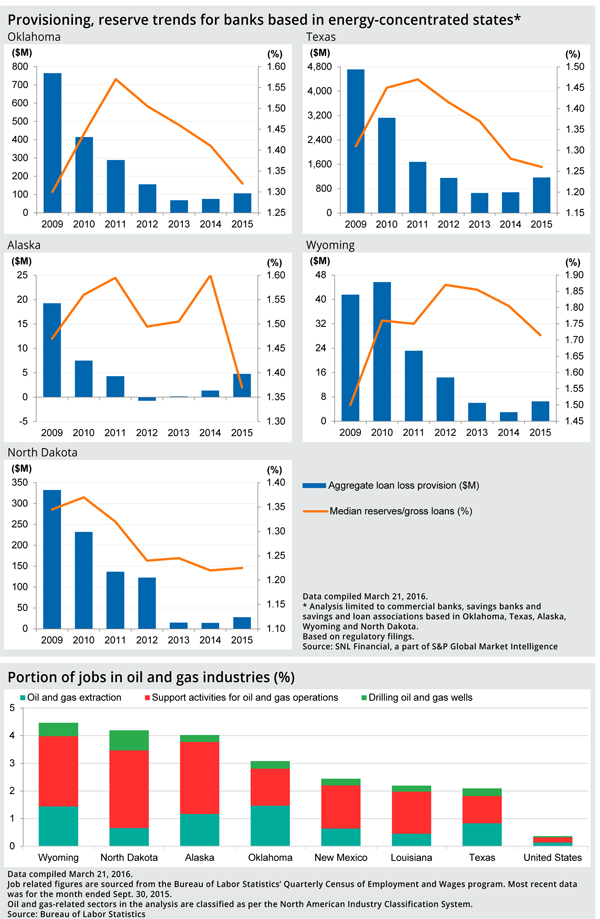Reserves up 25%+, more to come?
SNL Report: Banks in energy-exposed states feel pressure to provision
- |
- Written by SNL Financial
 SNL Financial, part of S&P Global Market Intelligence, is the premier provider of breaking news, financial data, and expert analysis on business sectors critical to the global economy. This article originally appeared on the subscriber side of SNL Financial's website.
SNL Financial, part of S&P Global Market Intelligence, is the premier provider of breaking news, financial data, and expert analysis on business sectors critical to the global economy. This article originally appeared on the subscriber side of SNL Financial's website.
By Zach Fox and Venkatesh Iyer, SNL Financial staff writers
Banks headquartered in oil-heavy states increased loan loss provisioning at a far greater rate than U.S. banks generally in the 2015 fourth quarter. But since reserves are coming up from a low base, some analysts think banks will need to keep provisioning at elevated levels to deal with the energy fallout.
In Texas, where a significant number of the nation's oil-and-gas-related jobs are concentrated, banks increased provisioning by 71.94% year over year to $1.17 billion in 2015. Elsewhere, the provision increases were even more dramatic, with doubling in Wyoming and tripling in Alaska.
Nationally, provisioning was up 24.19% year over year. Banks have posted large increases in part because provisioning is at a historically low level. Todd Baker, managing principal for Broadmoor Consulting, said investors can expect banks to post increased provisioning rates over the next year or two due to both the collapse in oil prices and cyclicality, as banks have released reserves for years and cannot take them any lower.
Banks have reported increases in classified loans, or loans that could be in danger of default, but charge-offs remain very low.
"It feels like we're in the very early innings of a baseball game that's not a very fun one," said Christopher Marinac, director of research for FIG Partners. "The ongoing building of reserves is going to be robust for some time."
Report from Casper, Wyo.
While it may be early innings, metro areas dependent on oil and gas are already feeling some pain. Across the U.S. there are roughly 512,000 people employed in oil and gas extraction, support services or drilling wells; nearly 48% of them are in Texas, according to U.S. Department of Labor figures from September 2015. Few cities are as exposed as Casper, Wyo. The area's employment base was roughly 26 times more concentrated in drilling oil and gas wells than the nation in September 2015.
The oil and gas sector is already shedding jobs in the region, according to recently released census data. Drilling jobs were down 50.9% and oil and gas support jobs were down 33.9% year over year in September 2015.
Casper-based Hilltop National Bank ($904.1 million in assets) holds nearly 30% of Casper's deposits. Five of the bank's six branches are in the metropolitan statistical area. Despite being Casper's main bank, President and CEO Greg Dixson said Hilltop National has zero direct energy exposure.
All the same, some credit softness has cropped up in Hilltop National's loan portfolio. The amount of commercial and industrial loans past due by at least 30 days doubled in the fourth quarter of 2015 from the linked quarter, although the increase was offset by a decline in past due real estate loans.
"We're having to spend more time on the phone, visiting people and prompting them to pay," Dixson said. "Our efforts in collections are more than they were in the past."
Dixson said retailers in the area are starting to feel pressure and commercial real estate rents have started to decline. However, he said the residential real estate sector continues to show strength.
During the 2015 fourth quarter, Dixson said the bank made a one-time provisioning expense of $250,000 in response to the weak macroeconomic outlook. In addition to regular provisioning, the expense brought the bank's total provisions to $360,000 in 2015, up from $60,000 in 2014.
Ultimately, provisioning in the face of a downturn involves some guesswork, FIG Partners' Marinac said. While banks can model for the severity of loss from a defaulted loan, he said banks have little idea of how many loans will go bad. "Because you can't know the frequency, they're still stabbing at it," he said.
Dixson said he is not concerned about the increase in 30-day delinquencies since past dues are still historically low at less than 1% of gross loans, and the bank has maintained a highly liquid balance sheet with a loan-to-deposit ratio of 30.8% in the fourth quarter of 2015. The low ratio is largely the result of a large spike in deposits at the bank over the last five years without a corresponding increase in loans.
"Providing a return to our shareholders is important, but we want to be around for the next year and year after that," Dixson said. He said the bank will manage the energy downturn by working proactively with borrowers to figure out payment plans. And the cycle could provide an opportunity for new accounts, as larger banks shed exposure to the region regardless of an individual borrower's track record.
Reports from other energy lenders
Large banks have also ramped up provisioning in response to the oil crash, most notably JPMorgan Chase & Co. The nation's largest bank more than doubled its provisioning expense in the 2015 fourth quarter from the linked quarter, and management said at an investor day that they expect to build reserves during the first quarter of around $500 million for oil and gas and about $100 million in metals and mining.
Banks appear eager to increase reserves for energy loan losses beyond the current rate of loan deterioration.
For example, Gulfport, Miss.-based Hancock Holding Co. reported a relatively flat number of classified energy loans, yet the company increased its allowance for energy loan losses by $43 million during the fourth quarter of 2015. Chief credit risk officer Sam Kendricks said during the company's earnings call that a certain amount of loans did move into the classified category, but the increase was offset by resolutions.
That sort of provisioning prudence and the greatly increased levels of capital since the credit crisis have some analysts believing banks are well-prepared to weather the energy downturn. Marinac said he does not expect to see a significant number of bank failures because banks have sufficient capital buffers.
Broadmoor Consulting's Baker also said he does not expect many failures. He said the larger banks have plenty of capital and have improved risk management practices generally. Further, many investors will be eager to recapitalize banks in order to get some energy exposure.
"There is a lot of capital interested in buying into energy at the bottom," Baker said. "It will be a rough patch for energy-exposed banks, but none of what's happening now, in my estimation, will affect the viability of any of these banks."
Profiting from past lessons?
Just as banks might have learned some lessons from the 2008 credit crisis about sufficient capital buffers, oil-exposed economies might have learned about managing energy cycles. Economies in Texas, in particular, have diversified away from energy after the 1980s oil crisis triggered hundreds of bank failures.
And Dixson of Hilltop National said the Casper community will be able to handle whatever $30 oil offers.
"Wyoming is so accustomed to energy-related boom and bust," he said. "Oil is going to come back, and natural gas will probably come back even sooner. For people around here—especially those who have been around here for a long time—this is just another cycle."
This article originally appeared on SNL Financial’s website under the title, "Banks in energy-exposed states feel pressure to provision"
Related items
- Banking Exchange Hosts Expert on Lending Regulatory Compliance
- Merger & Acquisition Round Up: MidFirst Bank, Provident
- FinCEN Underestimates Time Required to File Suspicious Activity Report
- Retirement Planning Creates Discord Among Couples
- Wall Street Looks at Big Bank Earnings, but Regional Banks Tell the Story















